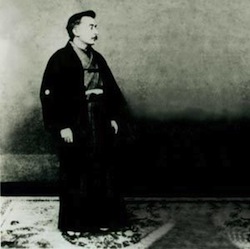Lafcadio Hearn, an Irish-Greek journalist, became a Japanese citizen in 1895 and under his new name, Koizumi Yakumo, crafted retellings of Japanese folktales. Koizumi was his wife’s last name. Yakumo, I’m told, derives from “Yakumo datsu” meaning “eight clouds rising” referring to an old Japanese poem as well as to Matsue in Shimane, where he lived. I think this means Hearn identified very strongly with both the place and the literature.
Hearn has been dismissed by some as an orientalist, romanticizing what he saw as exotic. There’s some truth to that, but I think it’s largely an undeserved criticism. I think he was as enmeshed in Japanese culture as he could be, and the otherness in his stories is supernatural rather than cultural, even though he wrote with the deliberate intention of introducing a western audience to unfamiliar folklore. While many westerner writers, despite their best efforts, retain an us-and-them approach to non-western stories, you could read some of Koizumi Yakumo’s stories without realizing that he wasn’t Japanese by birth.
His most famous story collection, Kwaidan, is primarily a series of ghost stories, which he learned from his wife or other native Japanese people as he travelled. His voice is calm and measured, seldom going in for melodrama and verbal theatrics. Compared to many other turn-of-the-century writers, he comes across rather sparse. I think this is one of his strengths. He doesn’t beat the reader over the head. He retells in such an unaffected manner as to give the reader the feeling of a true story, no matter how impossible the topic. 
Sixty years after the book, in Masaki Kobayashi’s 1964 film Kwaidan, four ghost stories were selected from various Hearn anthologies. “The Woman of the Snow,” (Yuki-Onna) and “Hoichi the Earless” (Mimi-Nashi-Hoichi) come from Kwaidan, the book. In each of the four stories, a mortal interacts with the spirit realm and makes an error.
The film opens with slow close-ups of pigment diffusing in water. How Kobayashi chose this, I cannot say, but it’s brilliant. There’s something hypnotic in the slow dance of fluid in fluid. It’s reminiscent of sumi and of blood, of banners and shrouds, and the interplay of corporeal and ethereal. It’s calming and eerie at once, the perfect combination for a film that blurs dream and nightmare.
I first saw Kwaidan when I was a young boy. Of the four stories, my favorite, then and now, is Hoichi the Earless. It’s really two stories intertwined. One is a scene from the Tale of the Heike, in which Emperor Antoku, the child-sovereign dies at the naval battle of Dan-no-ura (and the scowling faces of drowned samurai appear on crabs, which I think is fabulous). The other part of the story is a supernatural event in the life of a blind biwa player named Hoichi, who is considered particularly skilled in reciting the Tale (and it may be worth noting that Hearn was nearly blind). Hoichi stays at Amidaji, a temple housing the memorial site for Antoku. A mysterious samurai employs him to perform, and every night he does so only to return drained and deathly. The priests of Amidaji realize ghosts of Heike warriors are using Hoichi. To protect him they cover his body in Chinese characters from the Prajnaparamita Sutra (incidentally, if you’ve seen the Chinese Ghost Story movies, the Chinese translation of the title to the Prajnaparamita Sutra is used there, too, as a ward against ghosts). The sutra characters are meant to render Hoichi invisible to the ghosts. Alas, the priests forgot to paint Hoichi’s ears, and so when the ghosts return, that’s the only part of him they see, and they take his ears with them. Ouch.
 The part with Hoichi feels like a dark play, while the battle of Dan-no-ura is almost ukiyo-e brought to life. Kwaidan, in all four stories, alternates visually between intense darkness and brilliant color. The transitions, whether sudden or gradual, are always unsettling. The viewer is never really allowed to become comfortable. Menace is never far away. The “soundtrack” is silence, wind and instrumentation suited to the stage, but no orchestrated music.
The part with Hoichi feels like a dark play, while the battle of Dan-no-ura is almost ukiyo-e brought to life. Kwaidan, in all four stories, alternates visually between intense darkness and brilliant color. The transitions, whether sudden or gradual, are always unsettling. The viewer is never really allowed to become comfortable. Menace is never far away. The “soundtrack” is silence, wind and instrumentation suited to the stage, but no orchestrated music.
Akira Kurasawa, the Japanese director best known to western audiences, made use of film noir, realist and expressionist techniques. While I think it impossible that Kurasawa didn’t influence Kobayashi, I think that Kwaidan‘s greatest influence is traditional Japanese theater styles, Noh, Bunraku and Kabuki.
At no point does the film feel realistic. It feels staged, enclosed, slow-moving and deliberate. Dreamlike performances play out on rich, colorful sets that never look like anything but sets. Done poorly it would have felt cheap and fake. But instead it’s as beautiful, cold and exquisitely unreal as The Cabinet of Doctor Caligari.
When Jason Henninger isn’t reading, writing, juggling, cooking or raising evil genii, he works for Living Buddhism magazine in Santa Monica, CA.










